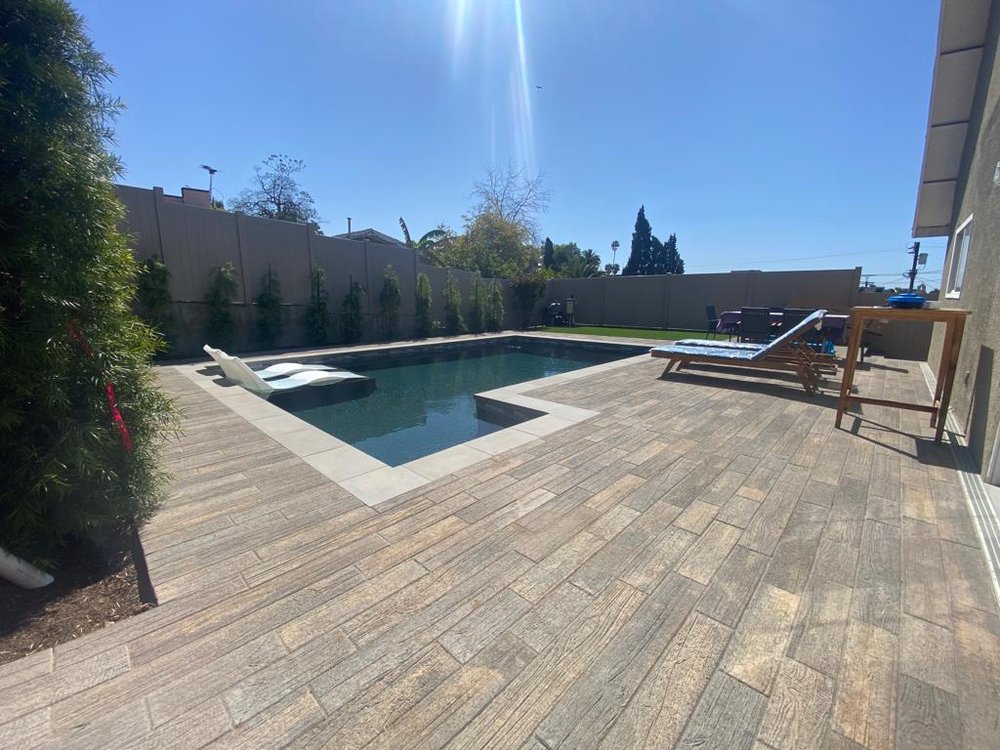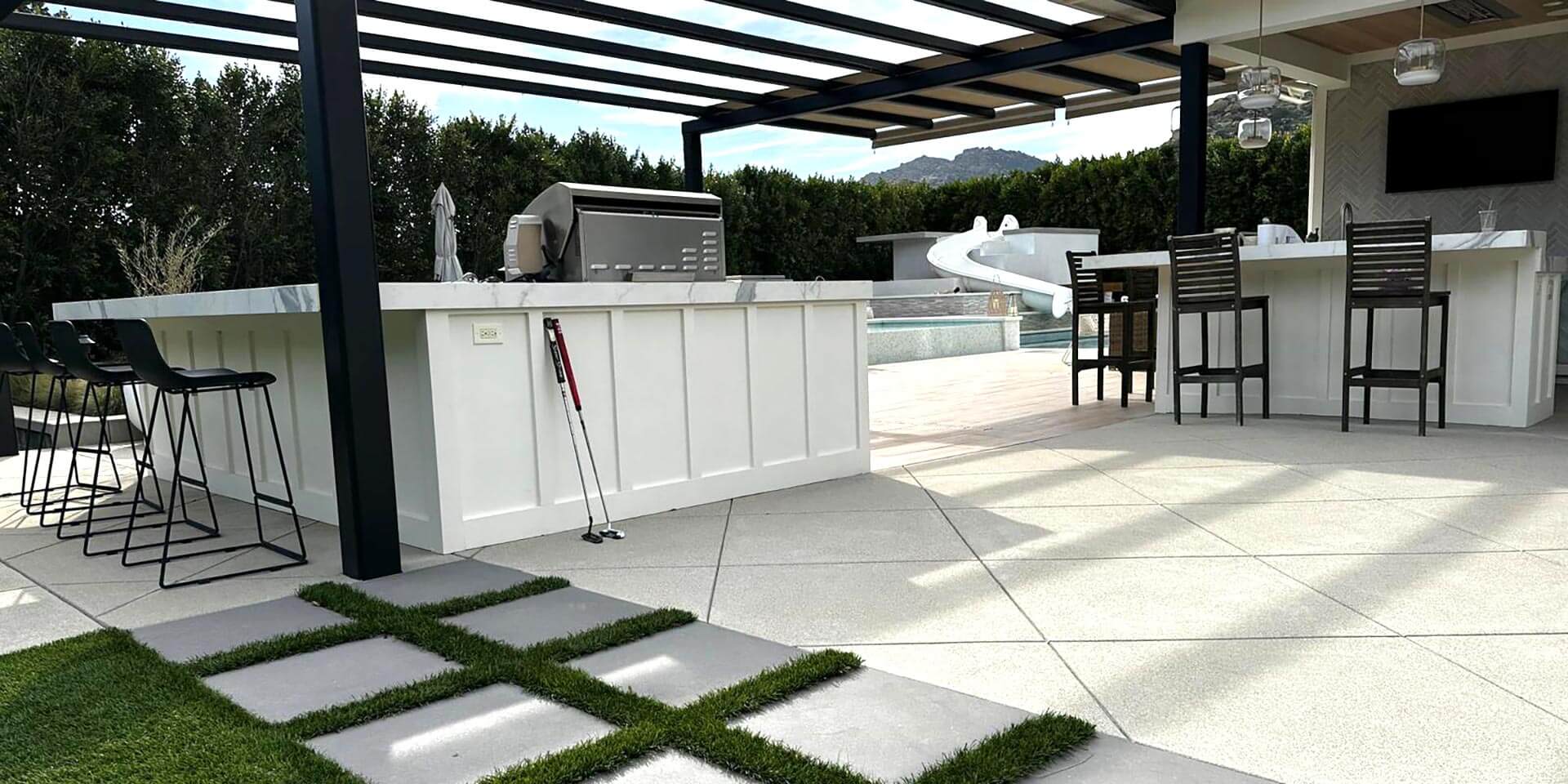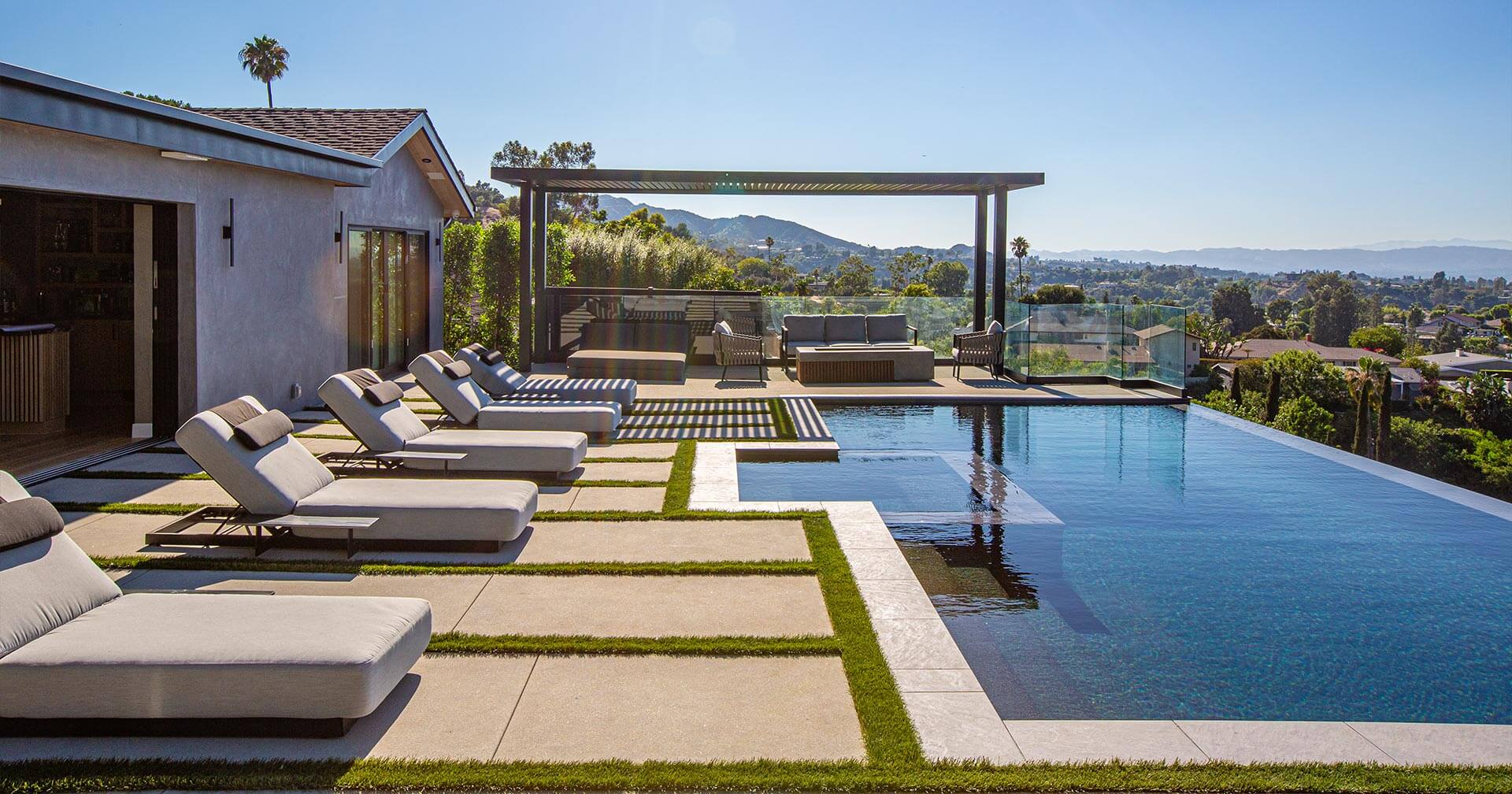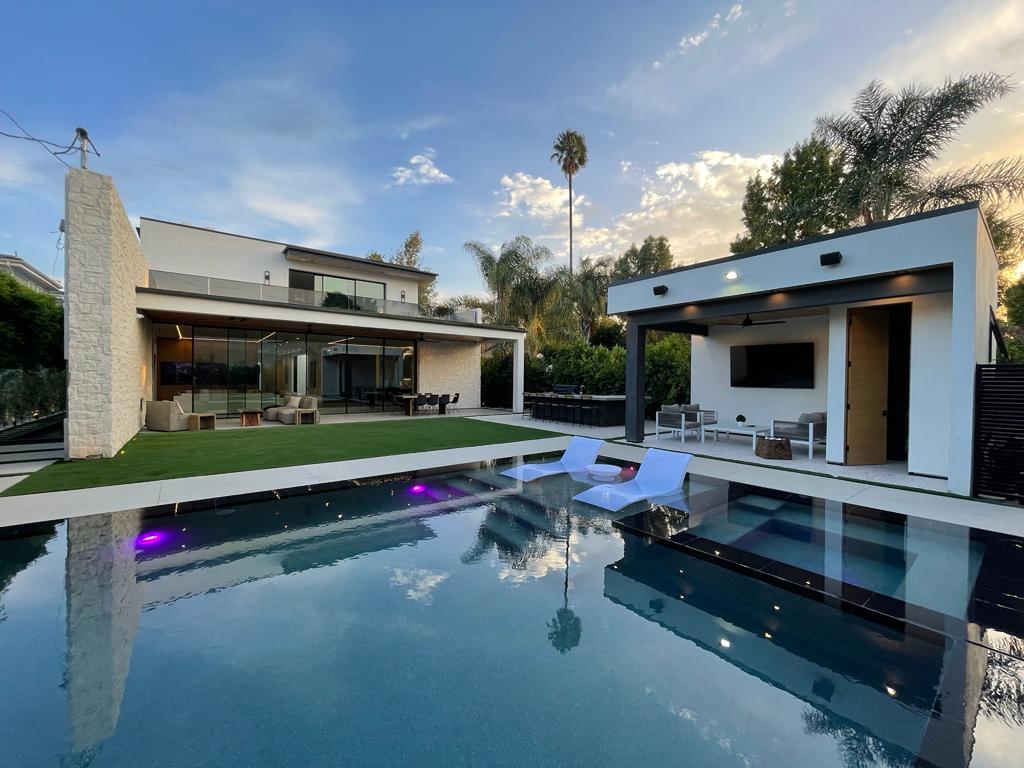When it comes to designing the perfect outdoor space, choosing the right material for your patio, walkways, or pool deck is one of the most important decisions you’ll make. The choice between concrete, pavers, and wood decking can significantly impact not only the aesthetic appeal of your backyard but also its functionality, maintenance, and cost. In this guide, we’ll break down the pros and cons of each material, helping Los Angeles homeowners make an informed decision that aligns with their lifestyle, budget, and design preferences.
Understanding Your Options: Concrete, Pavers, and Wood Decking
Before diving into the specific advantages and disadvantages of each material, it’s essential to understand what each option entails:
- Concrete: A versatile and durable material, concrete is often used for patios, driveways, and pool decks. It can be poured in various shapes and finished with different textures and colors.
- Pavers: Pavers are small, individual units made from concrete, brick, or natural stone that are laid in a pattern to create surfaces like patios, walkways, and driveways. They come in a variety of shapes, sizes, and colors.
- Wood Decking: Wood decking refers to platforms built from natural wood or composite materials, typically elevated from the ground. It’s a popular choice for creating a warm, inviting outdoor living space.
1. Concrete: Durability and Versatility
Advantages of Concrete:
- Cost-Effective: Concrete is generally one of the most affordable options for large areas, making it a popular choice for patios, driveways, and pool decks.
- Durability: Properly installed and maintained, concrete can last for decades. It’s resistant to the harsh sunlight and weather conditions common in Los Angeles.
- Versatility: Concrete can be poured into almost any shape, allowing for custom designs that fit your space perfectly. It can also be stamped, stained, or textured to mimic the appearance of more expensive materials like stone or brick.
- Low Maintenance: Concrete requires minimal maintenance. Regular sealing and cleaning will keep it looking good and protect it from staining and weather damage.
Disadvantages of Concrete:
- Cracking: Over time, concrete may develop cracks, especially if the ground beneath it shifts. While small cracks can be repaired, they can detract from the overall appearance.
- Heat Retention: Concrete tends to absorb and retain heat, making it uncomfortable to walk on barefoot during hot LA summers.
- Limited Aesthetic: While concrete can be customized, it may lack the natural beauty and texture of materials like wood or stone.
Is Concrete Right for You?
Concrete is an excellent choice if you’re looking for a durable, cost-effective material that requires minimal upkeep. It’s especially suitable for large areas like patios, driveways, or pool decks where budget and durability are primary concerns. If you’re in a neighborhood like Encino or Sherman Oaks, where practical, long-lasting materials are favored, concrete could be the ideal solution.
2. Pavers: Aesthetic Appeal and Flexibility
Advantages of Pavers:
- Aesthetic Variety: Pavers come in various shapes, sizes, colors, and materials (e.g., brick, concrete, stone), allowing you to create custom designs that complement your home’s architecture and landscaping.
- Durability: Pavers are extremely durable and can withstand heavy foot traffic and weather conditions. If a paver becomes damaged, it can be easily replaced without disturbing the rest of the surface.
- Flexibility in Design: The modular nature of pavers allows for creative patterns and designs. Whether you prefer a classic herringbone pattern, a contemporary grid, or something more intricate, pavers offer endless possibilities.
- Slip Resistance: Many pavers have a textured surface, providing natural slip resistance, which is ideal for pool decks and walkways.
Disadvantages of Pavers:
- Higher Cost: Pavers can be more expensive than concrete, especially if you choose natural stone or custom designs. The cost of installation is also higher due to the labor-intensive process.
- Weed Growth: Without proper installation and maintenance, weeds can grow between the pavers. However, this can be managed with regular upkeep and the use of joint sand or polymeric sand.
- Maintenance: While individual pavers can be replaced, maintaining a uniform look may require occasional resealing or re-leveling.
Are Pavers Right for You?
If you’re looking for a material that offers a high level of customization and aesthetic appeal, pavers are an excellent choice. They’re perfect for homeowners in upscale neighborhoods like Beverly Hills or Pacific Palisades, where attention to detail and curb appeal are paramount. While they may require a larger initial investment, the visual impact and longevity of pavers often justify the cost.
3. Wood Decking: Warmth and Natural Beauty
Advantages of Wood Decking:
- Natural Aesthetic: Wood decking provides a warm, inviting appearance that blends seamlessly with outdoor environments. It’s ideal for creating a cozy, natural feel in your backyard.
- Comfort: Wood decking remains cool underfoot, even during hot weather, making it comfortable to walk on barefoot.
- Versatility: Wood decks can be built at various levels, incorporating stairs, railings, and other features to create distinct outdoor living spaces. It can be stained or painted to match your home’s exterior or personal taste.
- Eco-Friendly Options: If sustainability is a priority, there are many eco-friendly wood options available, such as FSC-certified lumber or composite decking made from recycled materials.
Disadvantages of Wood Decking:
- Maintenance: Natural wood requires regular maintenance, including staining, sealing, and occasional sanding, to prevent warping, splintering, and weather damage. Composite decking offers lower maintenance but at a higher cost.
- Susceptible to Damage: Wood is vulnerable to moisture, insects, and UV damage. Without proper care, it can rot, warp, or fade over time.
- Higher Cost: High-quality wood or composite decking materials can be expensive, and installation costs are generally higher than concrete.
Is Wood Decking Right for You?
Wood decking is perfect for homeowners who value natural beauty and comfort in their outdoor spaces. If you live in a neighborhood like Malibu or Topanga Canyon, where a rustic, natural aesthetic is prized, wood decking can enhance the connection between your home and its surroundings. Just be prepared for the ongoing maintenance that comes with preserving its appearance and durability.
Making the Right Choice for Your Los Angeles Home
Choosing between concrete, pavers, and wood decking depends on several factors, including your budget, aesthetic preferences, maintenance commitment, and how you plan to use the space. Here are some key considerations to help guide your decision:
- Budget: If you’re working within a tight budget, concrete may be the best option. However, if you have more flexibility, investing in pavers or wood decking can add significant value and appeal to your home.
- Maintenance: Consider how much time and effort you’re willing to dedicate to upkeep. Concrete and pavers generally require less maintenance than wood, although pavers may need occasional re-leveling or resealing.
- Aesthetic Goals: Think about the overall look you want to achieve. If you’re aiming for a sleek, modern appearance, concrete might be the way to go. For a more traditional or natural look, pavers or wood decking could be better suited to your vision.
- Climate and Environment: Los Angeles’ climate can be harsh on outdoor materials. Choose a material that will hold up well under the local weather conditions and suits the environment of your specific neighborhood.
Popular Neighborhoods and Material Trends in Los Angeles
Different neighborhoods in Los Angeles have unique styles and preferences when it comes to outdoor materials. Here’s a look at what’s trending in some of LA’s top areas:
- Calabasas: High-end homes in Calabasas often feature luxurious pavers in intricate patterns, adding to the property’s elegance and sophistication.
- LA: Coastal homes in LA favor wood decking, which complements the beachy, laid-back atmosphere while providing a comfortable, barefoot-friendly surface.
- West Hollywood: Modern and minimalist, Hollywood homes frequently use sleek, polished concrete for patios and pool decks, emphasizing clean lines and contemporary design.
- Pasadena: In historic Pasadena, homeowners often opt for brick or stone pavers to enhance the charm and character of their homes’ exteriors.
Conclusion: Enhance Your Outdoor Space with the Right Material
Choosing the right material for your outdoor space is a crucial step in creating a backyard that meets your needs and enhances your home’s value. Whether you prefer the durability and affordability of concrete, the aesthetic flexibility of pavers, or the natural warmth of wood decking, each material has its unique benefits that can be tailored to your specific goals.
If you’re ready to start your outdoor project and need expert guidance, Moda Outdoor Living is here to help. Our team of experienced professionals will work with you to choose the best materials and design a space that reflects your style and suits your lifestyle.
Contact us today to schedule a consultation and begin the journey toward your dream outdoor living space.



